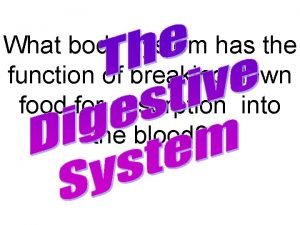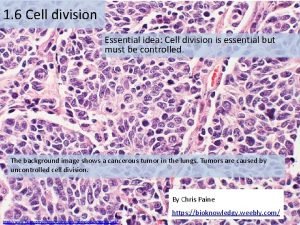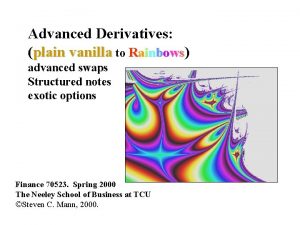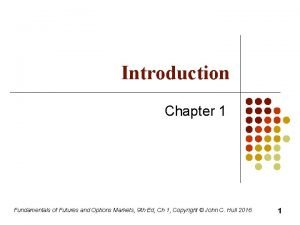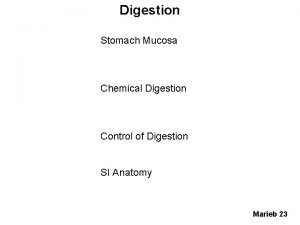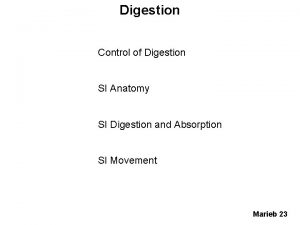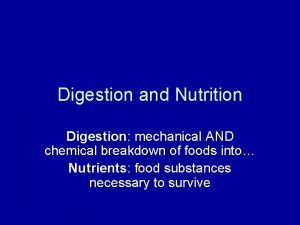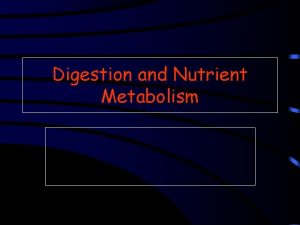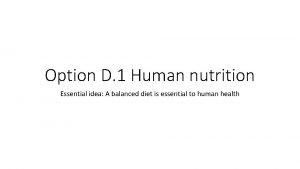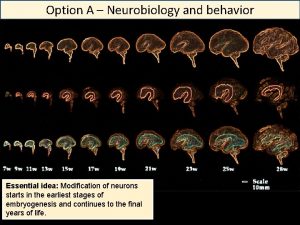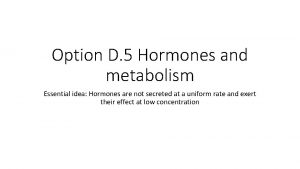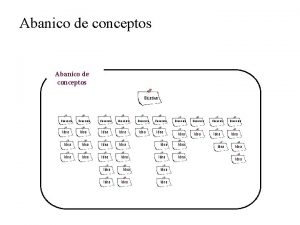Option D 2 Digestion Essential Idea Digestion is























- Slides: 23

Option D. 2: Digestion

Essential Idea: Digestion is controlled by nervous and hormonal mechanisms.

Understandings • U. D. 2. 1: Nervous and hormonal mechanisms control the secretion of digestive juices. • U. D. 2. 2: Exocrine glands secrete to the surface of the body or the lumen of the gut. • U. D. 2. 3: The volume and content of gastric secretions are controlled by nervous and hormonal mechanisms. • U. D. 2. 4: Acid conditions in the stomach favor some hydrolysis reactions and help to control pathogens in ingested food. • U. D. 2. 5: The structure of cells of the epithelium of the villi is adapted to the absorption of food. (Include microvilli and mitochondria) • U. D. 2. 6: The rate of transit materials through the large intestine is positively correlated with their fiber content. • U. D. 2. 7: Materials not absorbed are egested.

Applications and Skills • A. D. 2. 1: The reduction of stomach acid secretion by proton pump inhibitor drugs. • A. D. 2. 2: Dehydration due to cholera toxin. • A. D. 2. 3: Helicobacter pylori infection as a cause of stomach ulcers. • S. D. 2. 1: Identification of exocrine gland cells that secrete digestive juices and villus epithelium cells that absorb digested foods from electron micrographs.

Exocrine glands (U. D. 2. 2) • Previously we defined glands as structures that secrete some kind of substance. • Exocrine glands are those that secrete a substance that is useful for a particular location in the body and are transported there by a duct. • Some exocrine glands make secretions for transport to the surface of the body, such as lacrimal ducts that make tears, sweat glands that make sweat (duh), and mammary glands which produce milk. • Other exocrine glands send secretions to the lumen of the alimentary canal.

Digestive secretions Exocrine Secretion Gland Ducts leads to Function Salivary glands Mouth Moistens food and contains amylase Gastric juice Various cells in the stomach pits Interior of the stomach Mucus protects the stomach; HCl breaks down proteins; pepsin is an enzyme Pancreatic juice Pancreatic cells Duodenum Trypsin, lipase, and amylase are enzymes; bicarbonate solution increases p. H of food entering from the stomach Bile Liver Gall bladder and duodenum Emulsification (breakdown) of fats

Acinus • One group of secretory cells, clustered around the end of a duct is called an acinus. The ducts and acini in part of the pancreas that secretes pancreatic juice were shown. Acinus is unit of an exocrine gland. Secretory cells have adaptations.

Exocrine gland cells have distinctive features: • i) 1 or 2 prominent nucleoli inside nucleus for production of ribosomes. • ii) an extensive area of rough e. r. for protein synthesis. • iii) Golgi apparatus for processing proteins. • iv) Many large vesicles called secretory granules for storage of the substances to be secreted and transport of them to the plasma membrane. Usually densely stained because of the great concentrations of proteins. • v) Mitochondria to provide ATP for protein synthesis and other activities.

Pancreas Acinus (S. D. 2. 1)

Gastric secretions and their control • Recall the stomach is a holding tank for food. • Additionally, the stomach is responsible for the digestion of food. • There are three different types of exocrine glands responsible for gastric secretions: mucus cells, chief cells, and parietal cells.

Stomach pit anatomy

Nervous and hormonal control of the stomach (U. D. 2. 1 and U. D. 2. 3) • Before you even begin eating, your stomach is prepared for digestion by signals from the nervous system. • The vagus nerve from the brain will receive signal from the medulla oblongata region of the brain stem, and will pass those signals to the stomach. • These signals will begin the release of HCl and pepsinogen from the parietal and chief cells, respectively. • Vagus nerve signals also stimulate the release of a hormone called gastrin, which leads to the production of still more HCl and pepsinogen. • Once the pepsinogen comes into contact with the HCl, it transforms into the active enzyme pepsin, which is used to break down proteins.

Nervous and hormonal control cont. • As the stomach begins to fill with food and expands, signals from the stomach travel to the medulla oblongata via the vagus nerve (it’s paired; recall that action potentials travel in only one direction along the neuron). This stimulates the production of even more HCl and pepsinogen in an effort to continue and speed protein digestion (positive feedback). • As food works its way through the stomach, it is released through a small opening into the duodenum (first portion of the small intestine). In order to pass through, a small valve in the stomach opens, and this sends a signal to end the secretion of the acid and pepsinogen. • One of the signals is a hormone called secretin, which results in lower stomach activity.

Proton pump inhibitors (A. D. 2. 1) • Some people suffer from acid reflux disease, which is where excess stomach acid comes up into the esophagus. This is colloquially known as heart burn. • Also, some individuals may develop ulcers, or bleeding of the digestive wall tissue, as a result of stomach acid seeping into the duodenum. • A series of drugs known as proton pump inhibitors (PPIs) are available, and help reduce the amount of acid made by the gastric pits. • This reduces the amount of acid that can enter the esophagus and/or the duodenum, allowing the body to heal the tissue. • https: //www. youtube. com/watch? v=E 8 B 97 QS 0 ae. A

The role of HCl in digestion (U. D. 2. 4) • Recall that digestion is the process of breaking down large molecules into smaller molecules that can be absorbed by cells. • When proteins enter the stomach, they are in a 3 -D shape that is maintained by a variety of bonds within the structure of the protein. • When the protein is exposed to a p. H outside of its preferred range, the protein loses its 3 -D shape. This is denaturation. • The HCl in the stomach creates an extremely acidic environment and is capable of breaking down most proteins, which exposes the protein to proteases (protein-busting enzymes) so that it can be cleaved into amino acids for absorption. The process of breaking down macromolecules into monomers (using water) is known as hydrolysis. • The HCl is also responsible for activating the protease pepsinogen into its active form, pepsin. • Finally, the highly acidic environment is capable of killing most pathogens that enter into the body.

Causes of stomach ulcers (A. D. 2. 3) • Until recently, scientists believed that stomach ulcers were caused by an excess of stomach acid and/or stress. • The discovery of a bacteria species, Helicobacter pylori, led scientists to the conclusion that this bacteria could be the cause of many ulcers. • When H. pylori is introduced to the stomach, it will burrow under the mucous lining and infect cells lining the stomach. • The bacteria then release an enzyme called urease which creates ammonia, which in turn neutralizes the stomach’s acid. • The colonization of H. pylori in the stomach can lead to gastritis (inflammation of the stomach) and stomach ulcers. • Those who suffer from chronic gastritis as a result of the bacterial infection are much more likely to develop stomach cancer. • H. pylori the most common bacterial infection in the world, affecting an estimated 3 B people!

H. pylori

H. Pylori infection

Adaptations of villi epithelial cells (U. D. 2. 5) • Remember the structure of the villi epithelial cells in the intestine makes them particularly well suited for absorbing digested molecules. • Some of these adaptations and their functions include Microvilli – increase surface area to bring in more digested material Lacteal – absorbs digested fatty acids Capillary bed – transports digested molecules throughout the blood stream Large numbers of mitochondria – produce ATP needed for active transport *Tight junctions – “seals” between villi cells that prevents movement of intracellular fluid and dissolved molecules, maintaining concentration gradient • *Basal labyrinth – invaginations (infoldings) on the opposite side from the microvilli, increases surface area for transport out of the cell • *specific to the villi epithelial cells • • •

Cell identification (S. D. 2. 1) Lumen Brush border Tight junction Cell membrane Rough E. R. Mitochondrion Lysosome

Cholera (A. D. 2. 2) • Cholera is a disease that is caused by a bacterium, Vibrio cholera. • V. cholera releases a toxin that results in severe diarrhea. Since the body is releasing copious amounts of water with the diarrhea, this leads to dehydration, and is often fatal. • Cholera is spread through contaminated food and water. Though the problem is much less wide spread today, there are still many regions of the world that suffer this disease due to a lack of sanitation and clean drinking water.

Egestion (U. D. 2. 7) and the importance of fiber (U. D. 2. 6) • Most digestion takes place in the small intestine. • Some materials, like cellulose, lignin, bile pigments, and some bacteria, will never be digested. These materials will become feces, and ultimately egested (eliminated). • Fiber is made up mostly of cellulose and lignin, which are indigestible by humans. This material will provide bulk in the digestive tract, and gives the muscles in the tract some volume to push against. • This bulk the movement of material through the digestive tract, and there is a positive correlation with fiber content. • Additionally, fiber can help with BMI because foods high in fiber take up more space in the stomach, without adding excess calories. This provides a feeling of satiety, and decreases the likelihood of overeating.

That’s all, folks!
 Option terminology
Option terminology Konvergensi option adalah
Konvergensi option adalah Venn diagram of chemical and mechanical digestion
Venn diagram of chemical and mechanical digestion Characteristics of lipids
Characteristics of lipids Mitosis and cell cycle terminology
Mitosis and cell cycle terminology Penanda wacana
Penanda wacana Idea subject
Idea subject Is central idea and main idea the same
Is central idea and main idea the same Controlling idea examples
Controlling idea examples Exegetical idea vs homiletical idea
Exegetical idea vs homiletical idea Implied main idea
Implied main idea What is controlling idea
What is controlling idea What is negative option marketing
What is negative option marketing Put call partiy
Put call partiy Total return swap
Total return swap Index currency option notes
Index currency option notes Black scholes wikipedia
Black scholes wikipedia Multi period binomial option pricing model
Multi period binomial option pricing model What does preferential option for the poor mean
What does preferential option for the poor mean Girsanov theorem
Girsanov theorem Option hacker keene
Option hacker keene Human option 1
Human option 1 Forward vs option
Forward vs option Calloptionputoption
Calloptionputoption


